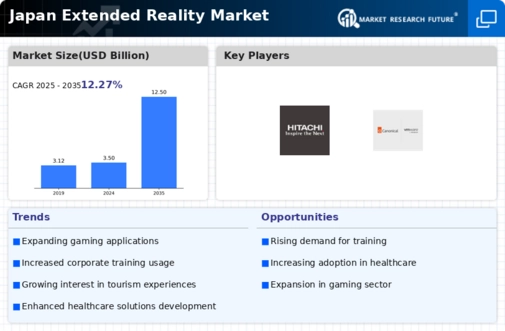The Japan Extended Reality Market is experiencing a dynamic transformation characterized by rapid technological advancements and a burgeoning interest in immersive experiences across various sectors, including entertainment, education, and manufacturing. With a mix of established companies and innovative startups, this market is highly competitive. Various players are leveraging augmented reality (AR), virtual reality (VR), and mixed reality (MR) technologies to enhance user engagement and drive new revenue streams. Companies are focusing on creating unique and impactful experiences that can cater to diverse consumer needs while also keeping pace with global trends.
The competitive landscape is further intensified by collaborations and strategic partnerships aimed at enhancing technological capabilities and expanding market reach.Nikon has made significant strides in the Japan Extended Reality Market, leveraging its expertise in imaging and technology to develop compelling XR solutions. The company's strengths lie in its strong brand recognition, a robust portfolio of high-quality imaging products, and a commitment to innovation.
By integrating its advanced optics into XR applications, Nikon is effectively establishing a competitive edge that allows it to bridge the gap between photography and immersive experiences. The company also benefits from its extensive network and expertise in precision instruments, enabling it to create superior XR experiences that appeal to both consumer and business segments. With a focus on enhancing user experiences through its technologies, Nikon is well-positioned to capitalize on growing trends in AR and VR.Capcom has carved a niche for itself in the Japan Extended Reality Market primarily through its renowned gaming franchises and innovative content offerings.
The company's commitment to creating engaging experiences is reflected in its key products and services, which include groundbreaking VR games that utilize advanced graphics and immersive sound to captivate players. Capcom’s market presence is strengthened by its focus on high-quality interactive entertainment and its ability to adapt its popular titles for various XR platforms. Additionally, the company has engaged in strategic collaborations and partnerships to enhance its technological capabilities and expand its XR portfolio.
Capcom's strengths are rooted in its creative talent, marketing prowess, and the ability to harness user feedback, all of which contribute to a continual evolution of its VR offerings. In a rapidly changing landscape, Capcom's agility and innovative approach to content creation position it favorably in the growing Japanese XR market.












